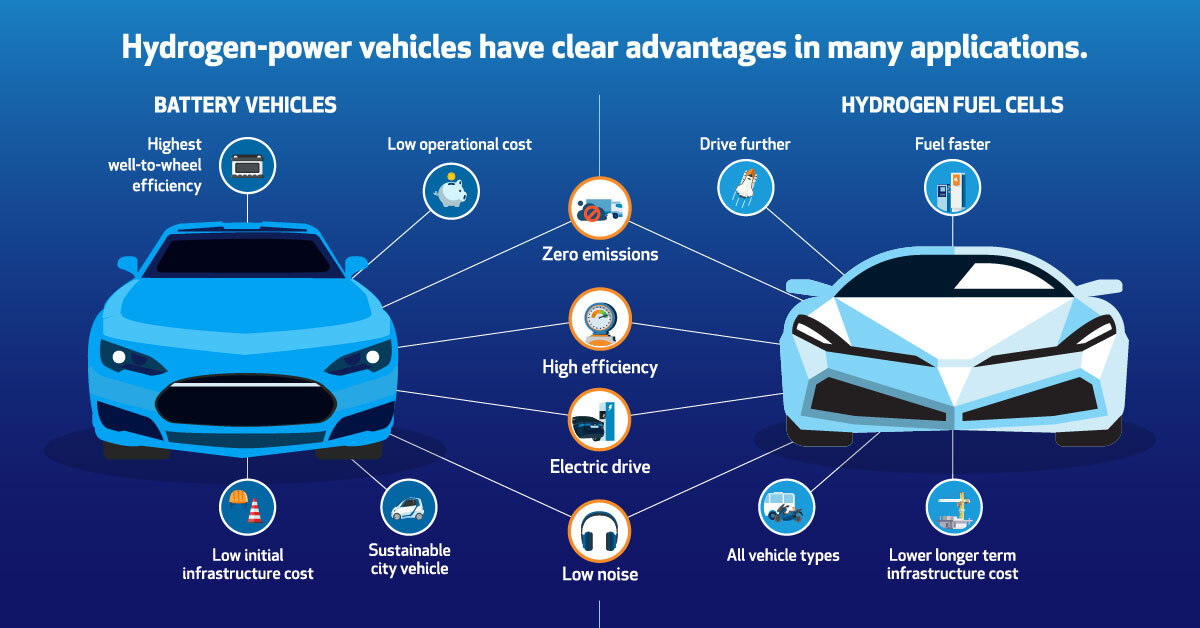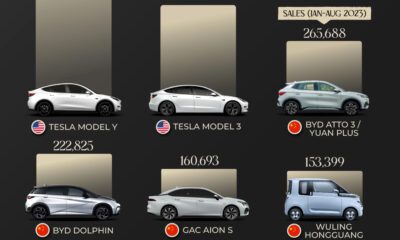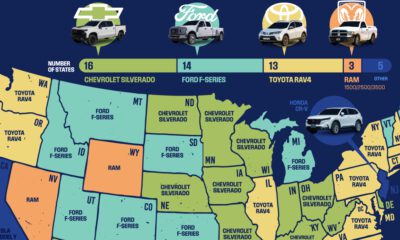Energy
6 Ways Hydrogen and Fuel Cells Can Help Transition to Clean Energy
While fossil fuels offer an easily transportable, affordable, and energy-dense fuel for everyday use, the burning of this fuel creates pollutants, which can concentrate in city centers degrading the quality of air and life for residents.
The world is looking for alternative ways to ensure the mobility of people and goods with different power sources, and electric vehicles have high potential to fill this need.
But did you know that not all electric vehicles produce their electricity in the same way?
Hydrogen: An Alternative Vision for the EV
The world obsesses over battery technology and manufacturers such as Tesla, but there is an alternative fuel that powers rocket ships and is road-ready. Hydrogen is set to become an important fuel in the clean energy mix of the future.
Today’s infographic comes from the Canadian Hydrogen and Fuel Cell Association (CHFCA) and it outlines the case for hydrogen.

Hydrogen Supply and Demand
Some scientists have made the argument that it was not hydrogen that caused the infamous Hindenburg to burst into flames. Instead, the powdered aluminum coating of the zeppelin, which provided its silver look, was the culprit. Essentially, the chemical compound coating the dirigibles was a crude form of rocket fuel.
Industry and business have safely used, stored, and transported hydrogen for 50 years, while hydrogen-powered electric vehicles have a proven safety record with over 10 million miles of operation. In fact, hydrogen has several properties that make it safer than fossil fuels:
- 14 times lighter than air and disperses quickly
- Flames have low radiant heat
- Less combustible
- Non-toxic
Since hydrogen is the most abundant chemical element in the universe, it can be produced almost anywhere with a variety of methods, including from fuels such as natural gas, oil, or coal, and through electrolysis. Fossil fuels can be treated with extreme temperatures to break their hydrocarbon bonds, releasing hydrogen as a byproduct. The latter method uses electricity to split water into hydrogen and oxygen.
Both methods produce hydrogen for storage, and later consumption in an electric fuel cell.
Fuel Cell or Battery?
Battery and hydrogen-powered vehicles have the same goal: to reduce the environmental impact from oil consumption. There are two ways to measure the environmental impact of vehicles, from “Well to Wheels” and from “Cradle to Grave”.
Well to wheels refers to the total emissions from the production of fuel to its use in everyday life. Meanwhile, cradle to grave includes the vehicle’s production, operation, and eventual destruction.
According to one study, both of these measurements show that hydrogen-powered fuel cells significantly reduce greenhouse gas emissions and air pollutants. For every kilometer a hydrogen-powered vehicle drives it produces only 2.7 grams per kilometer (g/km) of carbon dioxide while a battery electric vehicle produces 20 g/km.
During everyday use, both options offer zero emissions, high efficiency, an electric drive, and low noise, but hydrogen offers weight-saving advantages that battery-powered vehicles do not.
In one comparison, Toyota’s Mirai had a maximum driving range of 312 miles, 41% further than Tesla’s Model 3 220-mile range. The Mirai can refuel in minutes, while the Model 3 has to recharge in 8.5 hours for only a 45% charge at a specially configured quick charge station not widely available.
However, the world still lacks the significant infrastructure to make this hydrogen-fueled future possible.
Hydrogen Infrastructure
Large scale production delivers economic amounts of hydrogen. In order to achieve this scale, an extensive infrastructure of pipelines and fueling stations are required. However to build this, the world needs global coordination and action.
Countries around the world are laying the foundations for a hydrogen future. In 2017, CEOs from around the word formed the Hydrogen Council with the mission to accelerate the investment in hydrogen.
Globally, countries have announced plans to build 2,800 hydrogen refueling stations by 2025. German pipeline operators presented a plan to create a 1,200-kilometer grid by 2030 to transport hydrogen across the country, which would be the world’s largest in planning.
Fuel cell technology is road-ready with hydrogen infrastructure rapidly catching up. Hydrogen can deliver the power for a new clear energy era.
Energy
The World’s Biggest Nuclear Energy Producers
China has grown its nuclear capacity over the last decade, now ranking second on the list of top nuclear energy producers.

The World’s Biggest Nuclear Energy Producers
This was originally posted on our Voronoi app. Download the app for free on Apple or Android and discover incredible data-driven charts from a variety of trusted sources.
Scientists in South Korea recently broke a record in a nuclear fusion experiment. For 48 seconds, they sustained a temperature seven times that of the sun’s core.
But generating commercially viable energy from nuclear fusion still remains more science fiction than reality. Meanwhile, its more reliable sibling, nuclear fission, has been powering our world for many decades.
In this graphic, we visualized the top producers of nuclear energy by their share of the global total, measured in terawatt hours (TWh). Data for this was sourced from the Nuclear Energy Institute, last updated in August 2022.
Which Country Generates the Most Nuclear Energy?
Nuclear energy production in the U.S. is more than twice the amount produced by China (ranked second) and France (ranked third) put together. In total, the U.S. accounts for nearly 30% of global nuclear energy output.
However, nuclear power only accounts for one-fifth of America’s electricity supply. This is in contrast to France, which generates 60% of its electricity from nuclear plants.
| Rank | Country | Nuclear Energy Produced (TWh) | % of Total |
|---|---|---|---|
| 1 | 🇺🇸 U.S. | 772 | 29% |
| 2 | 🇨🇳 China | 383 | 14% |
| 3 | 🇫🇷 France | 363 | 14% |
| 4 | 🇷🇺 Russia | 208 | 8% |
| 5 | 🇰🇷 South Korea | 150 | 6% |
| 6 | 🇨🇦 Canada | 87 | 3% |
| 7 | 🇺🇦 Ukraine | 81 | 3% |
| 8 | 🇩🇪 Germany | 65 | 2% |
| 9 | 🇯🇵 Japan | 61 | 2% |
| 10 | 🇪🇸 Spain | 54 | 2% |
| 11 | 🇸🇪 Sweden | 51 | 2% |
| 12 | 🇧🇪 Belgium | 48 | 2% |
| 13 | 🇬🇧 UK | 42 | 2% |
| 14 | 🇮🇳 India | 40 | 2% |
| 15 | 🇨🇿 Czech Republic | 29 | 1% |
| N/A | 🌐 Other | 219 | 8% |
| N/A | 🌍 Total | 2,653 | 100% |
Another highlight is how China has rapidly grown its nuclear energy capabilities in the last decade. Between 2016 and 2021, for example, it increased its share of global nuclear energy output from less than 10% to more than 14%, overtaking France for second place.
On the opposite end, the UK’s share has slipped to 2% over the same time period.
Meanwhile, Ukraine has heavily relied on nuclear energy to power its grid. In March 2022, it lost access to its key Zaporizhzhia Nuclear Power Station after Russian forces wrested control of the facility. With six 1,000 MW reactors, the plant is one of the largest in Europe. It is currently not producing any power, and has been the site of recent drone attacks.
-

 Maps2 weeks ago
Maps2 weeks agoMapped: Average Wages Across Europe
-

 Money1 week ago
Money1 week agoWhich States Have the Highest Minimum Wage in America?
-

 Real Estate1 week ago
Real Estate1 week agoRanked: The Most Valuable Housing Markets in America
-

 Markets1 week ago
Markets1 week agoCharted: Big Four Market Share by S&P 500 Audits
-

 AI1 week ago
AI1 week agoThe Stock Performance of U.S. Chipmakers So Far in 2024
-

 Automotive2 weeks ago
Automotive2 weeks agoAlmost Every EV Stock is Down After Q1 2024
-

 Money2 weeks ago
Money2 weeks agoWhere Does One U.S. Tax Dollar Go?
-

 Green2 weeks ago
Green2 weeks agoRanked: Top Countries by Total Forest Loss Since 2001















